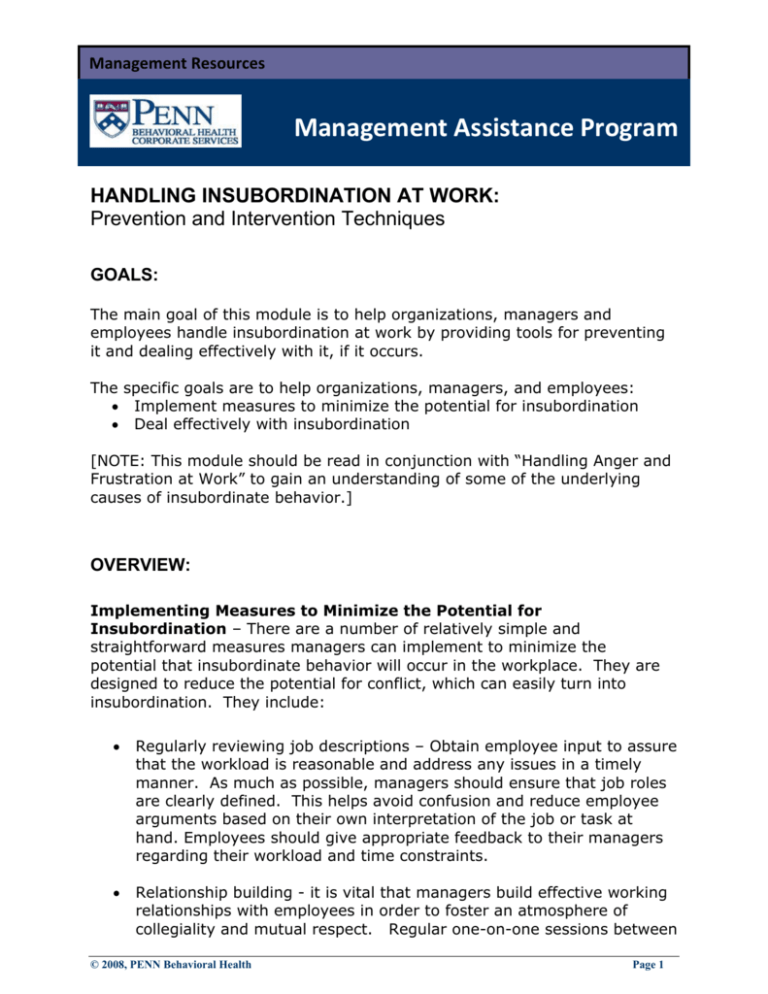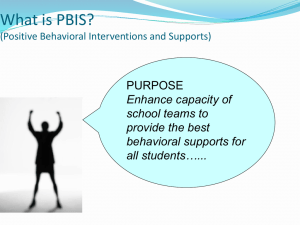Handling Insubordination at Work
advertisement

Management Resources Management Assistance Program HANDLING INSUBORDINATION AT WORK: Prevention and Intervention Techniques GOALS: The main goal of this module is to help organizations, managers and employees handle insubordination at work by providing tools for preventing it and dealing effectively with it, if it occurs. The specific goals are to help organizations, managers, and employees: • Implement measures to minimize the potential for insubordination • Deal effectively with insubordination [NOTE: This module should be read in conjunction with “Handling Anger and Frustration at Work” to gain an understanding of some of the underlying causes of insubordinate behavior.] OVERVIEW: Implementing Measures to Minimize the Potential for Insubordination – There are a number of relatively simple and straightforward measures managers can implement to minimize the potential that insubordinate behavior will occur in the workplace. They are designed to reduce the potential for conflict, which can easily turn into insubordination. They include: • Regularly reviewing job descriptions – Obtain employee input to assure that the workload is reasonable and address any issues in a timely manner. As much as possible, managers should ensure that job roles are clearly defined. This helps avoid confusion and reduce employee arguments based on their own interpretation of the job or task at hand. Employees should give appropriate feedback to their managers regarding their workload and time constraints. • Relationship building - it is vital that managers build effective working relationships with employees in order to foster an atmosphere of collegiality and mutual respect. Regular one-on-one sessions between © 2008, PENN Behavioral Health Page 1 Management Resources employees and mangers as well as regular informal staff or group meetings can help ease tensions and provide opportunities to discuss and address issues before they escalate into conflicts. Employees should respect the position of their managers and try to continually meet their defined goals and objectives. • Good communication at all levels will also contribute to a feeling of trust. Managers should communicate verbally and in writing regarding expectations, plans and anticipated changes to keep employees informed about issues that will affect them. Similarly, managers should request regular written updates and status reports on individual and team efforts. E-mails are not always the best forms of communication when dialogue is needed to resolve issues. • Providing training programs for managers and employees can also greatly reduce conflicts in the workplace. Training should include seminars on communication and listening skills, interpersonal dynamics in good working relationships, and conflict management. • Developing procedures for routine tasks so that everyone knows what is expected. A daily routine with lists of projects and tasks to be accomplished keeps everyone clear on the current goals and objectives. Dealing With Insubordination – Research shows that four out of ten employees will have personal problems that impact work at some point in their lives and one out of every 20 is suffering from major depression. Failure to have clearly stated policies and procedures to deal with anger, frustration and insubordination in the workplace can leave a company vulnerable to the behavioral whims of employees, lead to serious work-flow disruptions that impact the bottom line, and, in some cases, leave the organization open to legal liability. Similarly, failure to provide managers with training and tools for handling conflict/insubordination can increase legal risk and prevent them from intervening before a situation becomes critical. Employees also need to know and understand the rules and guidelines of the organization’s culture and safety restrictions. Insubordination is broadly defined as an unwillingness to submit to authority, either through an open refusal to obey an order, failure to carry out an order, or an attempt to undermine managerial authority. This is a common problem in the workplace. In the workplace, insubordination comes in many forms, such as: • Outright refusal to carry out an order • Actively challenging or criticizing a superior’s order © 2008, PENN Behavioral Health Page 2 Management Resources • Interfering with management • Showing open disrespect toward a supervisor • Making threats • Using coercion or physical violence • Using abusive language • Making malicious statements • Ignoring instructions The following examples from workrelationships.com are used here to illustrate various types of insubordination. • Yerke, a Finnish expatriate, is hired as head of the IT Department of a large computer peripherals manufacturing company. He is dumbfounded when, after two weeks on the job, his boss complains that he is a troublemaker who openly questions his decisions and challenges his authority. • Pam, a stellar employee, is disciplined for insubordination when she called in sick after her request for personal leave to attend her daughter’s out-of-town wedding was denied. • Raymond is the top sales representative of his company. He makes more sales that the rest of the sales team put together. He is loved by his customers, but three sales managers have quit because of his abusive language and disrespectful attitude toward them. Numerous warnings were given but with no real consequences. Discipline is often an appropriate response to insubordination. However, it can be seen from the above examples that there are varying reasons for, and degrees of, rebellious or disrespectful behavior. Before disciplinary action is taken, it is important to consider a number of factors for each individual case in order to decide upon a response or action that is appropriate to that particular situation. If an order is inappropriate, or out of bounds, or if the employee has a legitimate reason for refusing to carry out an order, there may be some flexibility in interpreting the employee’s response. Even though employees should rarely be allowed to challenge authority, there are some instances in which such a refusal is justified, including but not limited to the following. • Carrying out the order would endanger the health, welfare, or safety of the employee and/or other employees in the workplace • Carrying out the order involves an illegal act • The order is accompanied by religious, racist or sexist slurs © 2008, PENN Behavioral Health Page 3 Management Resources Generally, employees cannot decide for themselves which instructions they will or will not obey. Companies should make this clear in their policies and procedures and by stating in the employee handbook or personnel manual that insubordination is against company policy and that violation of this policy can result in disciplinary action up to and including termination. The policy should also state that, if an employee has a complaint about management behavior, they should follow the appropriate employee grievance process. Once it has been determined that an employee has engaged in insubordinate behavior, the next factor to be considered is the circumstance surrounding the behavior. For example: • • • • • Was the order direct, clear and unambiguous? Was a published policy or work rule violated? Did the employee recognize that a rule was broken? Was the employee aware of the consequences? Is the policy or rule itself the problem? Consider the above circumstances in light of the three example cases cited above. For instance: • Yerke had no awareness that his behavior was inappropriate because he came from a culture that is much less deferential to status or power differences. In this case, counseling him about the cultural differences not only changed his behavior but helped him understand that the reluctance of his subordinates to question or challenge him was not a result of disinterest or a lack of motivation as he had previously supposed. • Pam had been a stellar employee prior to this incident. While her response to denial of her request was inappropriate, denying this request in the first place was also questionable. Other alternatives, such as securing a temp or being available by phone could have been considered. • Tolerating Raymond’s disrespectful and abusive attitude not only adversely impacted the morale and retention rate of the sales team, but the numerous warnings with no consequences opens the company to legal risk if they choose to discipline another employee for a similar issue in the future. Thus, before deciding on disciplinary action, one needs to take into account all of the factors and circumstances involved. Most employers have a © 2008, PENN Behavioral Health Page 4 Management Resources progressive discipline policy to deal with conduct problems. This type of policy is most effective when it contains flexible language and does not link specific conduct to a specific disciplinary response. This allows the company to consider all factors and determine appropriate and constructive discipline on a case-by-case basis. Some of the factors that should be considered are the employee’s record, consequences of the act, mitigating factors, attitude, and past practice. When a determination has been made, guidelines for imposing any oral or written disciplinary action should include: • • • • • • • • • • • • • • • Carefully documenting the facts and chronology of the insubordinate behavior. Informing the employee that that he/she has engaged in specific conduct that is unacceptable (stating the exact nature of the conduct). Outlining the conduct that is expected (if appropriate, referring to the specific policy or rule of conduct). Explaining that the improper conduct must stop. Discussing the negative consequences that will occur if the employee fails to change the unacceptable behavior. Mentioning positive consequences of changing the improper behavior. Exploring reasons for the unacceptable behavior and developing an action plan for changing the behavior. The employee and manger should sign the plan. Documenting all instances of unacceptable behavior and all counseling or warnings given. Staying calm when confronting the employee, especially if the insubordination is chronic. Basing the confrontation on job performance only and not allowing personal feelings, comments or observations to get in the way of the counseling or disciplinary action. Assuring that the employee knows exactly what you are saying. Not allowing any room for confusion or possible misunderstanding. Ask the employee to paraphrase the discussion and document same. Not making value or personal judgments. Limiting discussion and action to the behavior or incident in question. Ensuring that any action taken is consistent with policies, guidelines and/or past actions taken with other employees in similar circumstances. Employees also need to be aware of their behaviors and the consequences of insubordination on both their continued employment and future references. © 2008, PENN Behavioral Health Page 5 Management Resources Therefore employees who have been warned or think they could be guilty of insubordinate actions or attitudes should ask themselves: • • • • • What about my tone of voice, posture, physical demeanor, facial expressions, abrupt responses or comments could be construed as offensive? How would I feel if I had to manage someone like myself and still accomplish my own goals and objectives? Could my actions be seen as inappropriate, subversive, or aggressive? Why do I feel I have to make a point to prove I’m right to my manager? What would be the most appropriate response to a difficult situation or problem? OBJECTIVES: 1. Implement measures to minimize the potential for insubordination Knowing how to deal with workplace conflict that can lead to insubordination is an essential skill for managers and an important lesson for employees. • Learn how to manage conflict effectively – It is important to recognize issues and patterns that can lead to workplace conflict and to have the training and tools needed to prevent conflict from developing if at all possible. • Implement Measures to Reduce the Potential for Insubordination – This strategy can help to remove the conditions – anger and frustration – that may lead to insubordinate behavior. Managers should be able to facilitate building and maintaining employee and group trust and be able to develop high levels of consensus in work values. Creating an atmosphere of collegiality can improve employee interactions in the workplace and reduce stress levels that can lead to conflicts. Employees need to show respect and develop appropriate relationships with their managers. • Know some of the key concepts that will help managers prevent conflict. o Conduct reviews of job descriptions regularly with employees to be sure you know what they are/should be doing. This will help avoid uneven workload distribution. © 2008, PENN Behavioral Health Page 6 Management Resources o Work at building relationships with employees that you manage and schedule informal staff meetings on a regular basis to encourage open and constructive communication between group members. o Communicate clearly and openly with employees to build a relationship of trust. • Seek training as needed, especially in areas that will help you develop the skills needed to manage both individual and team work relations. • Develop policies and procedures to cover routine tasks and outline specific procedures for addressing the more complex workplace issues, such as an employee grievance process, a progressive discipline policy, etc. • Provide education to staff regarding these policies and be sure all policies are implemented consistently. • Know some of the key concepts that will help employees prevent conflict. o Ask specific questions of your manager regarding workflow problems and potential frustrations o Work at building relationships with your manager and offer ideas and views when encouraged to engage in open and constructive communication. o Communicate clearly and openly with other employees to build a relationship of trust and support your manager and encourage other employees to share their concerns with the manager rather than complain about them. 2. Deal with insubordination Many different actions can constitute insubordination. It can be as clear as outright refusal to carry out a direct order or as subtle as making malicious statements. In general, insubordination should not be tolerated. When dealing with insubordination, managers should do the following: • Carefully document the facts and chronology of the insubordinate behavior. • Review each incident on a case-by-case basis to understand the specifics of the incident and review all circumstances and courses possible and strategies before deciding on a course of action. • Identify the issues involved. © 2008, PENN Behavioral Health Page 7 Management Resources • Consider the history of person/persons involved – have there been prior incidents? Is the employee having personal problems? Were there extenuating circumstances? • Consider the impact of the incident on operations – including its effect on workplace productivity, profits, other employees, etc. • Consider possible strategies for dealing with the incident. • Outline actions to be taken and review the consequences of these actions before making a decision. • Be sure that any disciplinary action to be taken is consistent with company policy or guidelines and that it is consistent with actions taken for similar incidents with other employees in the past. If you as an employee have engaged in subordination, you need to immediately apologize to your manager and be prepared to face the consequences of your actions. Here are some suggestions. • Be ready to respond to the charges of insubordinate behavior. • Do not try to defend inappropriate behaviors but rather concentrate on how your behaviors will immediately change. • Listen carefully to the specific actions or behaviors that need to be changed. • Offer constructive suggestions regarding how you will change your behaviors. • Consider the impact of the incident on operations – including its effect on workplace productivity, profits, other employees, etc. • Consider possible strategies for dealing with the incident in the future. • Realize that consequences have to occur to extinguish the behaviors in the future. • Accept that disciplinary action must be taken that is consistent with company policy or guidelines up to and including termination in some circumstances. © 2008, PENN Behavioral Health Page 8 Management Resources SUMMARY: Tips for Handling Insubordination at Work. • Implement measures to prevent conflict in the workplace, including: o Regularly reviewing job descriptions o Building relationships with employees o Establishing good communications at all levels o Providing training programs for managers and employees o Developing procedures for routine tasks • Be circumspect in dealing with issues; consider implications before taking action. • Be sure policies and procedures addressing the specific behavior are in place. • Be sure staff is educated on these policies. • Seek or provide training on topics pertaining to workplace relationships as appropriate. • If insubordinate behavior occurs, proceed with a clear plan. • If insubordination has been documented, do not enable its continuance. • If accused of insubordination, take the charges seriously. • If guilty of insubordination, do not try to justify it by regarding what other employees have done in the past. • If reprimanded for insubordination, do not argue over what you believe the manager should or should not do. © 2008, PENN Behavioral Health Page 9







